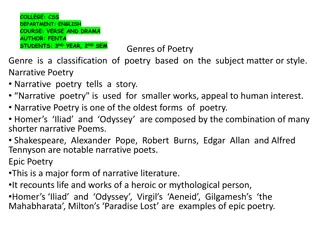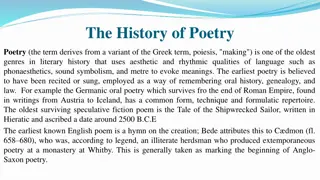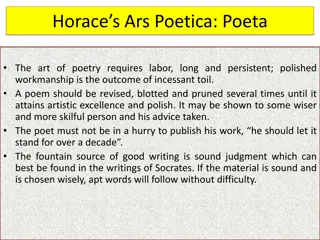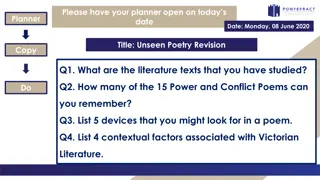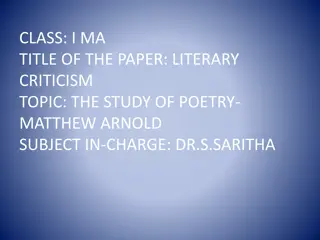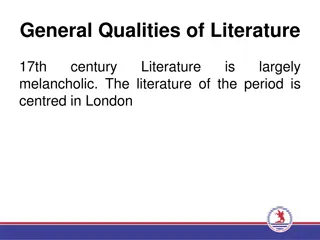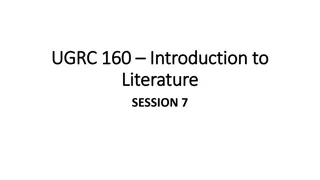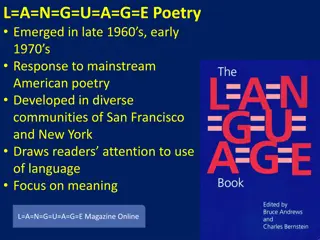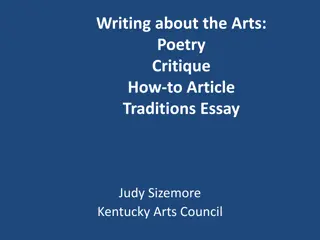The Legacy of Hilda Doolittle: A Pioneer of Modern American Poetry
Hilda Doolittle, known as H.D., was a trailblazing American poet and novelist associated with the Imagist movement. Through her rebellious and experimental approach, she reshaped poetry, empowering women and challenging conventions. Her iconic poem "Sea Rose" exemplifies Imagism with its vivid imagery and natural sound. H.D.'s significant contribution to Modern American Poetry continues to inspire generations to embrace change and individuality.
Download Presentation

Please find below an Image/Link to download the presentation.
The content on the website is provided AS IS for your information and personal use only. It may not be sold, licensed, or shared on other websites without obtaining consent from the author. Download presentation by click this link. If you encounter any issues during the download, it is possible that the publisher has removed the file from their server.
E N D
Presentation Transcript
H.D. (born Hilda Doolittle; September 10, 1886 September 27, 1961) was an American poet, novelist and memoirist known for her association with the early 20th-century avant-garde Imagist group of poets such as Ezra Pound and Richard Aldington.
Hilda Doolittle made a significant contribution to the tradition of Modern American Poetry. Her rebellious and experimental ways helped her reinterpret the world and poetry the way she saw it. Throughout her works, specifically Sea Rose and Moon in Your Hands, H.D. demonstrates the concept of change the idea of breaking from the status quo and not being afraid of who you are. By breaking free from the restraints of the imagist movement, incorporating her work with the lessons she learned from psychoanalysis, and spotlighting the female figure, H.D. was able to inspire change and give hope to women and others who were searching within themselves for greater meaning.
In her early life, H.D. participated in the imagist movement, a short-lived movement that followed Pound's (one of the founders of imagiste) imagist directives: 1. Direct treatment of the thing, whether subjective or objective. 2. To use absolutely no word that did not contribute to the presentation. 3. As regarding rhythm: to compose in sequence of the musical phrase, not in sequence of a metronome (Jaffe, 88). Imagism created a new style of poetry, changing the way poets looked at poetry. Imagist poems were direct, concise, and relied mostly on imagery to communicate its message. One object or image became the subject and main focus of the poem.
H.D.'s short poem SeaRose (1916), from her collection Sea Garden, defines imagism. The poem centers on the image of a rose that is unlike the traditional rose usually associated with feminine and beauty. Rather than softness and daintiness one would expect of a rose, this sea rose is rough and harsh. It is marred and spoiled by its stint of petals. H.D. does not waste her words; each word significantly adds meaning to her poem. Usingfew words, she is able to paint a picture of the sea rose, with its meager and thin flower and sparse leaves. As the poem progresses, H.D. depicts the sea rose being caught in the drift. She uses the word driven suggesting the fierceness of the wind, which tosses the rose, flung from the sea, and floating down onto the sand. The lack of a fixed meter or rhythm helps the reader follow on the image of the sea rose as it s being carried through the air. By allowing the consonants and vowels to echo each other throughout the poem, H.D. is able to create a natural sound. For instance, the repetition of the letter i in drift reappears in lifted, in, crisp, and wind (Overview: Sea Rose ). Moreover, all these words fit together into a description of how the rose is tossed around by the natural elements, further adding to this natural sound.
Looking deeper into the poem, Sea Rose does not only talk about a flower, but also explores H.D s difficulties as a woman author while at the same time defying society s definitions of feminine beauty and dealing with her own unique differences.This sea rose, defined by its lack of beauty and its ability to survive being tossed by the sea is a metaphor for H.D, whom after a stillborn child and a rocky love life, is able to withstand life's challenges.
H.D. no longer wanted to be limited in what she could write and no longer wanted to be burdened by the rules of the imagist movement. She wanted to free her mind, and express herself, and show who she was through her writing. She departed from literary and cultural conventions throughout her life in an attempt to reconcile her personal inner conflicts about her own identity (Morrison). H.D. took her own inner struggles and anxieties and invited and welcomed the idea that she was different. She was a woman in quest (Jaffe, 91). She did not know who she was, largely due to her confusing sexual identity. For most of her adult life, H.D. was on a journey to find an answer an answer that will define who she was.
Doolittle, Hilda. Tribute to Freud. New York: New Directions, 1984. Print. Firchow, Peter. "Hilda Doolittle."American Writers:A Collection of Literary Biographies, Supplement 1. Ed. Leonard Unger. New York: Charles Scribner's Sons, 1979.Literature Resource Center. Web. 12 May 2011. Friedman, Susan Stanford. "Hilda Doolittle."American Poets, 1880-1945:First Series. Ed. Peter Quartermain. Detroit: Gale Research, 1986. Dictionary of Literary Biography Vol. 45.Literature Resource Center. Web. 8 May. 2011







